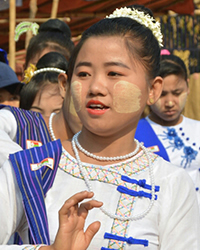Kadu, Asak in Myanmar (Burma)

Photo Source:
Asia Harvest-Operation Myanmar
|
Send Joshua Project a map of this people group.
|
| People Name: | Kadu, Asak |
| Country: | Myanmar (Burma) |
| 10/40 Window: | Yes |
| Population: | 188,000 |
| World Population: | 188,000 |
| Primary Language: | Kadu |
| Primary Religion: | Buddhism |
| Christian Adherents: | 5.00 % |
| Evangelicals: | 3.50 % |
| Scripture: | Portions |
| Ministry Resources: | Yes |
| Jesus Film: | No |
| Audio Recordings: | Yes |
| People Cluster: | Tibeto-Burman, other |
| Affinity Bloc: | Tibetan-Himalayan Peoples |
| Progress Level: |
|
Identity
The autonym of the members of this group is Asak or Sak, but all other ethnic groups in the area, and the government, know them as the Kadu. The Kadu, who say they are descended from the Chak people, are not to be confused with other similarly named tribes and languages in Asia, including the Katu (a Mon-Khmer tribe in Vietnam and Laos), the Kado of southwest China and Laos, and the Kaduo language spoken in Yunnan Province, China. For over a century the Kadu have been viewed as a distinct ethnic group in Myanmar, with the 1931 census returning a Kadu population of 36,400 people.
Location: More than 180,000 Kadu people are distributed in almost 100 villages across a wide area of three states and regions in northern Myanmar. Most live in seven districts of the Sagaing Region in the country's northwest, with lesser numbers in Kachin and Shan states. A 2019 news article provided specific locations for the Kadu: “There are 98 Kadu villages in Myanmar, of which 38 are in Bamauk, 16 in Pinlebu, 34 in Indaw, five in Katha, and five in Mogaung.” Another source says, “Kadu villages are located on spurs of hills just above the valley floor.”
Language: The Kadu language, which is part of the Sal branch of the Tibeto-Burman family, is endangered and is spoken by only about 30,000 Kadu people.3 This has created confusion regarding their population, as some sources only count those who can still speak the language rather than the whole ethnic group, which is over six times larger. Although most people now speak Burmese, three Kadu dialects remain in use, with Banmauk Township being the center of Kadu language use today. The people in more than 30 villages once spoke the Mawteik dialect, but it is now nearly extinct. Another 30 villages still use the Settaw dialect, and five villages are hanging on to their Mawkhwin dialect.4 Each of the three Kadu dialects has low comprehension with the other two, suggesting they may have different origins.
History
The Kadu people have a long recorded history, with one scholar confidently stating: “The Kadu likely descended from the Qiongdu, a subgroup of 'southwestern barbarians' who settled in present-day Myanmar during the Tang dynasty (AD 618-907), becoming a dominant group in the Tagaung Kingdom.” Identifying the Kadu throughout history is complicated by the assortment of names applied to them. A 1964 study noted: “They are called Kadu or Kado by the Burmese, Puteik by the Kachin, and Mawteik by the Shan…. Through intermarriage they are becoming Burmese in culture. Many of them work for Burmese lumbering firms as elephant drivers and wood cutters.”
Customs
Rice production is the main occupation of the Kadu, with tea and cotton also grown in the area. The traditional tribal customs of the Kadu have largely been lost during their assimilation of Burmese culture. A visitor remarked, “It was evident that Burmese culture is being chosen over the Kadu traditional lifestyle and cultural norms.” In a bid to revive Kadu culture, a three-day festival was established in 2017, affording a chance for Kadu people from different areas to come together and celebrate their common heritage.
Religion
The Kadu people are staunch Buddhists, although most of them consider their faith to be part of their cultural identity and are not active participants. An undercurrent of Animism still runs through the Kadu worldview, with guardian spirits feared and placated to obtain protection and blessings. In the 1931 census all but 22 of the 36,400 Kadu people said they were Buddhists, with no one identifying as a Christian.
Christianity
The only Scripture in the Kadu language consists of Bible portions published in 1939. The Roman script was used, but the booklet soon became obsolete. Due to the bold witness of Christians from the Kachin and other tribes, today around five percent of Kadu people believe in Jesus Christ, but the Buddhist majority remain unreached and are considered strongly resistant to the Gospel.